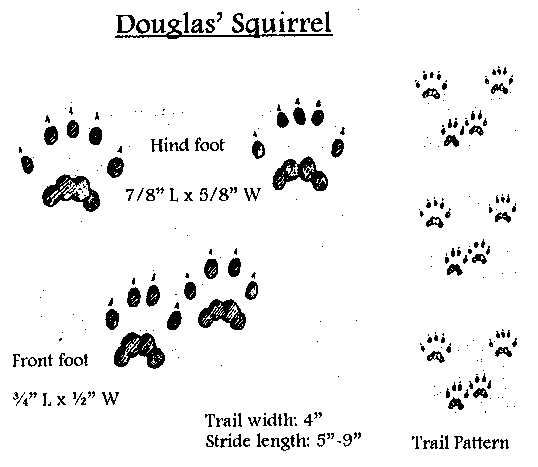![]() Douglasí Squirrel
Douglasí Squirrel ![]()

Douglasí Squirrel Tracks


![]() Natural History of Douglasí Squirrels
Natural History of Douglasí Squirrels ![]()
Douglas' squirrels are active during the day. They have rust red coats and white rings around the eyes. The underside is orange. Long, curved toenails act as hooks to help the animals climb. Douglas' squirrels build their nests high in trees. In summer, they build a nest out of lichens, mosses, twigs, and bark. In winter, their nests are located in holes in trees. They also live in ground burrows and sometimes move into and cap abandoned bird nests with sticks and leaves.
These squirrels are fairly noisy and will scold and chatter at people from their perches. Their tracks show four toes on the front foot and five toes on the hind foot. The young, usually a litter of four to six, are born in May or June. A family group may stay together for almost a year. Douglas' squirrels are also called pine squirrels or chickarees.
They eat green vegetation, new shoots of conifers, acorns, nuts, mushrooms, insects, fruits, and berries. They are fond of cones and will drop them to the ground and gather them up later for winter storage. They establish favorite feeding stations in the trees. They eat the seeds, which they get to by stripping the cones. Cone scales mound up on the ground below feeding stations in piles called middens. The squirrels also stash mushrooms in the forks of tree branches for later use. Douglas' squirrels open acorns by gnawing on the shells. You may find piles of these opened nuts beneath a tree where the squirrel has been working.
Common predators include bobcats, foxes, house cats, and owls. Humans raid the cone caches for seeds to be used in planting nursery trees.


![]() Personal Notes on Douglasí Squirrels
Personal Notes on Douglasí Squirrels ![]()
†
Find squirrel posters, greeting cards, t-shirts, hats, and more in my new store.
|
Now available: "Animals Don't Cover
Their Tracks - An Introduction to Animal Tracking" on CD! (Version 3.0)
New drawings, more species, more photos, more extensive sections on tracking
humans, more detailed directions for plaster casting, mystery tracks section,
tracking stories section, and more. The CD features over 100 species, including
special bonus sections with the tracks of some African and Australian
animals. A large section on tracking lost people for search and rescue is
included, with over four pages of photos showing the details of tracks and
signs people leave. Easy to use format. This web site is limited
by bandwidth, but the CD-ROM is not. The CD is available in my online store at:
www.dirt-time.com
Works with Mac or PC. Happy tracking!!
What else can you find in the nature store? Beartracker's animal tracks coloring book, T-shirts, sweatshirts, journals, book bags, toddler and infant apparel, mouse pads, posters, postcards, coffee mugs, travel mugs, clocks, Frisbees, bumper stickers, hats, stickers, and many more items. All with tracks or paw prints, or nature scenes. Custom products are available. If you don't see the track you want on the product you want, email me and I can probably create it. Proceeds from all sales go to pay the monthly fees for this web site. You can help support this site as well as get great tracking products! Thank you! |
| Find other tracking products: www.zazzle.com/tracker8459* |
| Also visit these fine
stores for more products of interest: NDN Pride shop - For Indian Pride items for all tribes. Custom items available on request. ASL Signs of Love - For anyone who uses or is learning ASL, American Sign Language. Custom name items and more are available here. Sales from all stores give commissions to Beartracker's Animal Tracks Den, which helps keep this site online as a free service. We are celebrating ten years online this year! |




Got a squirrel story? E-mail me and tell me about it.
Copyright © 1997-2008. Text and drawings by Kim A. Cabrera

